Drawing the Lines : Constraints on Partisan Gerrymandering in U.S. Politics / Nicholas R. Seabrook.
Material type: TextPublisher: Ithaca, NY : Cornell University Press, [2017]Copyright date: ©2017Description: 1 online resource (152 p.)Content type:
TextPublisher: Ithaca, NY : Cornell University Press, [2017]Copyright date: ©2017Description: 1 online resource (152 p.)Content type: - 9781501707797
- Apportionment (Election law) -- United States
- Gerrymandering -- United States
- Legal History & Studies
- Political Science & Political History
- U.S. History
- POLITICAL SCIENCE / Political Process / Campaigns & Elections
- gerrymandering, Texas governor Rick Perry, redistricting, congressional elections, partisanship, Florida
- 328.73/073455 23
- JK1341 .S39 2017eb
- online - DeGruyter
| Item type | Current library | Call number | URL | Status | Notes | Barcode | |
|---|---|---|---|---|---|---|---|
 eBook
eBook
|
Biblioteca "Angelicum" Pont. Univ. S.Tommaso d'Aquino Nuvola online | online - DeGruyter (Browse shelf(Opens below)) | Online access | Not for loan (Accesso limitato) | Accesso per gli utenti autorizzati / Access for authorized users | (dgr)9781501707797 |
Browsing Biblioteca "Angelicum" Pont. Univ. S.Tommaso d'Aquino shelves, Shelving location: Nuvola online Close shelf browser (Hides shelf browser)

|

|

|

|

|

|

|
||
| online - DeGruyter Public Workers : Government Employee Unions, the Law, and the State, 1900–1962 / | online - DeGruyter The Borscht Belt : Revisiting the Remains of America's Jewish Vacationland. | online - DeGruyter Killing Others : A Natural History of Ethnic Violence / | online - DeGruyter Drawing the Lines : Constraints on Partisan Gerrymandering in U.S. Politics / | online - DeGruyter Defiant Priests : Domestic Unions, Violence, and Clerical Masculinity in Fourteenth-Century Catalunya / | online - DeGruyter Architects of Occupation : American Experts and Planning for Postwar Japan / | online - DeGruyter A Minor Apocalypse : Warsaw during the First World War / |
Frontmatter -- Contents -- Introduction: Perceptions and Misperceptions of Partisan Redistricting -- 1. A Theory of Constrained Redistricting -- 2. The Unrealized Precedent of Davis v. Bandemer -- 3. Second-Order Challenges and the Rise of Mid-Decade Redistricting -- 4. Winning the Future? Redistricting and Partisan Bias -- 5. Redistricting, Electoral Responsiveness, and Democracy -- Conclusion: Implications for Redistricting Reform -- References -- Court Cases -- Index
restricted access online access with authorization star
http://purl.org/coar/access_right/c_16ec
Radical redistricting plans, such as that pushed through by Texas governor Rick Perry in 2003, are frequently used for partisan purposes. Perry’s plan sent twenty-one Republicans (and only eleven Democrats) to Congress in the 2004 elections. Such heavy-handed tactics strike many as contrary to basic democratic principles. In Drawing the Lines, Nicholas R. Seabrook uses a combination of political science methods and legal studies insights to investigate the effects of redistricting on U.S. House elections. He concludes that partisan gerrymandering poses far less of a threat to democratic accountability than conventional wisdom would suggest. Building on a large data set of the demographics of redrawn districts and subsequent congressional elections, Seabrook looks less at the who and how of gerrymandering and considers more closely the practical effects of partisan redistricting plans. He finds that the redrawing of districts often results in no detrimental effect for district-level competition. Short-term benefits in terms of capturing seats are sometimes achieved but long-term results are uncertain. By focusing on the end results rather than on the motivations of political actors, Seabrook seeks to recast the political debate about the importance of partisanship. He supports institutionalizing metrics for competitiveness that would prove more threatening to all incumbents no matter their party affiliation.
Mode of access: Internet via World Wide Web.
In English.
Description based on online resource; title from PDF title page (publisher's Web site, viewed 26. Apr 2024)


